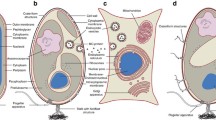Summary
The periplast ofHemiselmis brunnescens Butcher is a complex cell covering comprised of the plasma membrane (PM) sandwiched between a surface periplast component (SPC) and an inner periplast component (IPC). The SPC is revealed by deep-etching, and consists of hexagonal plates composed of tripartite subunits that appear to self-assemble into a crystalline layer with a hexagonal symmetry. Small scales (termed fibrillar scales) accumulate on the crystalline plates during cell growth, eventually forming a “carpet” that itself may appear crystalline when fully formed. Heptagonal “rosette scales” are occasionally observed on the surface as well. The position of the crystalline plates is precisely mirrored by both the E and P fracture faces of the PM. The plate proper is underlain by membrane with a high concentration of intramembrane particles (IMPs) while the bands of membrane underlying the plate borders lack IMPs. Access of subunits and fibrillar scales to the cell surface following initial plate formation appears to be at the plate boundaries. This study suggests that cryptomonad flagellates may provide model systems for studying the self-assembly of cell surface components, and for relating membrane structure to function, as evidence suggests a major role for the PM in mediating periplast assembly and development.
Similar content being viewed by others
References
Brett, S., Wetherbee, R., 1986: A comparative study of periplast structure inCryptomonas cryophila andC. ovata (Cryptophyceae). Protoplasma131, 23–31.
Catt, J. W., Hills, G. J., Roberts, K., 1976: A structural glycoprotein, containing hydroxyproline, isolated from the cell wall ofChlamydomonas reinhardii. Planta (Berl.)131, 165–176.
Faust, M. A., 1974: Structure of the periplast ofCryptomonas ovata var.palustris. J. Phycol.10, 121–124.
Gantt, E., 1971: Micromorphology of the periplast ofChroomonas (Cryptophyceae). J. Phycol.7, 177–184.
Grim, J. N., Staehelin, L. A., 1984: The ejectisomes of the flagellateChilomonas paramecium: Visualization by freeze-fracture and isolation techniques. J. Protozool.3 (12), 259–267.
Guillard, R. R. L., Ryther, J., 1962: Studies on marine planktonic diatoms. I.Cyclotella nana Hustedt andDetonula confervaceae (Cleve)Gran. Can. J. Microbiol.8, 229–239.
Hausmann, K., Walz, B., 1979: Periplastruktur und Organisation der Plasmamembran vonRhodomonas spec. (Cryptophyceae). Protoplasma101, 349–354.
Hill, D. R. A.,Wetherbee, R., 1986:Proteomonas sulcata gen. et sp. nov. (Cryptophyceae), a cryptomonad with two morphologically distinct and alternating forms. Phycologia (in press).
Ludwig, M., Gibbs, S. P., 1985: DNA present in the nucleomorph ofCryptomonads: further evidence that the chloroplast evolved from a eukaryotic endosymbiont. Protoplasma127, 9–20.
McFadden, G. I., Wetherbee, R., 1985: Flagellar regeneration and associated scale deposition inPyramimonas gelidicola (Prasinophyceae, Chlorophyta). Protoplasma128, 31–37.
Moestrup, Ø., Walne, P. L., 1979: Studies on scale morphogenesis in the Golgi apparatus ofPyramimonas tetrarhynchus (Prasinophyceae). J. Cell Sci.36, 437–459.
Pennick, N. C., 1981: Flagellar scales inHemiselmis brunnescens Butcher andH. virescens Droop. Arch. Protistenk.124, 267–270.
—, 1982: Observations of the fine structure ofHemiselmis brunnescens Butcher. Arch. Protistenk.126, 241–245.
Romanovicz, D. K., 1981: Scale formation in flagellates. In: Cell Biology Monographs (Kiermayer, O., ed.),8, pp. 27–62. Wien-New York: Springer.
Santore, U. J., 1977: Scanning electron microscopy and comparative micromorphology of the periplast ofHemiselmis rufescens, Chroomonas sp. and members of the genusCryptomonas (Cryptophyceae). Br. phycol. J.12, 255–270.
—, 1982 a: The ultrastructure ofHemiselmis brunnescens andHemiselmis virescens with additional observation onHemiselmis rufescens and comments on theHemiselmidaceae as a natural group of theCryptophyceae. Br. Phycol. J.17, 81–99.
—, 1982 b: Comparative ultrastructural of two members of theCryptophyceae assigned to the genusChroomonas-with comments on their taxonomy. Arch. Protistenk.125, 5–28.
—, 1983: Flagellar and body scales in theCryptophyceae. Br. Phycol. J.18, 239–248.
—, 1984: Some aspects of taxonomy in theCryptophyceae. New Phytol.98, 627–646.
Sleytr, U. B., Messner, P., 1983: Crystalline surface layers on bacteria. Ann. Rev. Microbiol.37, 311–339.
Staehelin, L. A., Pickett-Heaps, J. D., 1975: The ultrastructure ofScenedesmus (Chlorophyceae). 1. Species with the “reticulate” or “warty” type of ornamental layer. J. Phycol.11, 163–185.
Author information
Authors and Affiliations
Rights and permissions
About this article
Cite this article
Wetherbee, R., Hill, D.R.A. & McFadden, G.I. Periplast structure of the cryptomonad flagellateHemiselmis brunnescens . Protoplasma 131, 11–22 (1986). https://doi.org/10.1007/BF01281683
Received:
Accepted:
Issue Date:
DOI: https://doi.org/10.1007/BF01281683




